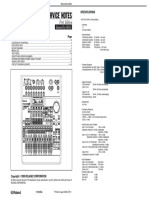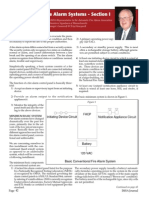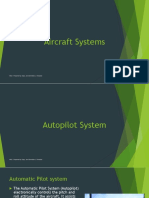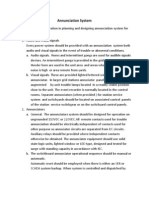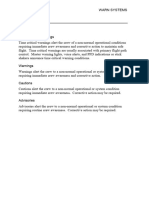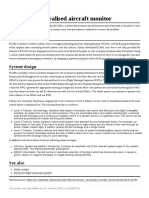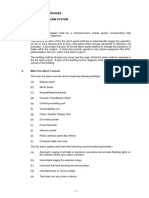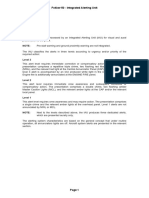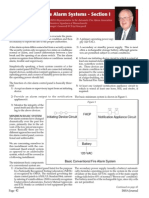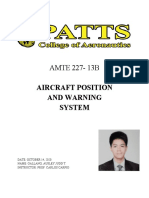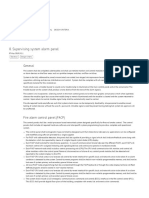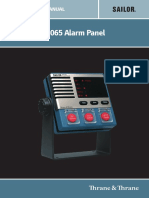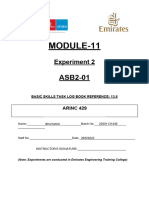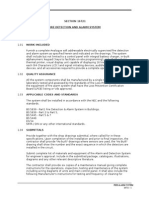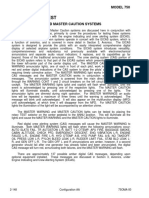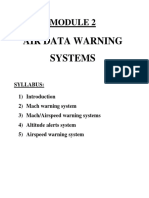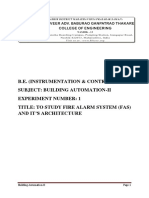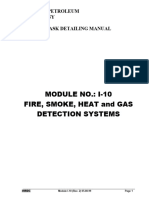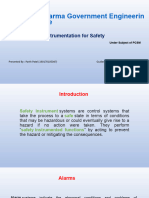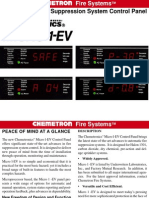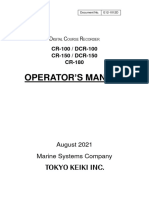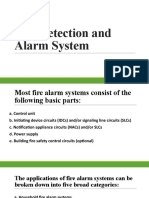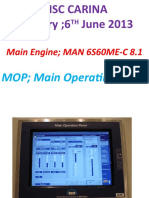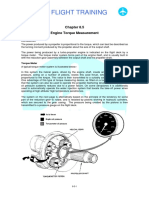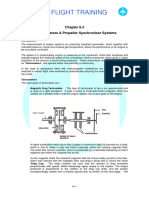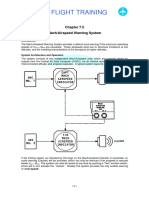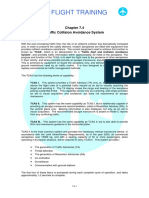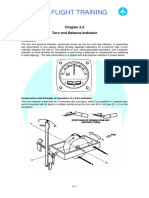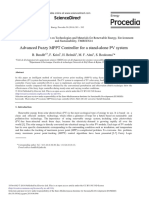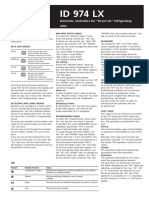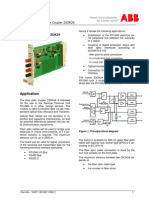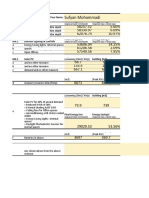ATPL Inst 7.1 PDF
ATPL Inst 7.1 PDF
Uploaded by
Koustubh VadalkarCopyright:
Available Formats
ATPL Inst 7.1 PDF
ATPL Inst 7.1 PDF
Uploaded by
Koustubh VadalkarOriginal Title
Copyright
Available Formats
Share this document
Did you find this document useful?
Is this content inappropriate?
Copyright:
Available Formats
ATPL Inst 7.1 PDF
ATPL Inst 7.1 PDF
Uploaded by
Koustubh VadalkarCopyright:
Available Formats
WILJAM FLIGHT TRAINING
Chapter 7.1
Central Warning System
Introduction
In modern aeroplanes many systems require constant monitoring, which in turn require a
corresponding multitude of warning devices; both visual and aural, to be fitted. These warnings
consist of flashing lights, horns and bells, which if operating in various parts of the flight deck
could pose an unnecessary distraction. In order to reduce this probability, aeroplanes are
equipped with a Central Warning System (CWS).
Central Warning System Annunciator Panel
In its basic form, the system comprises of a group of warning and indicator lights, which are
connected to signal circuits allied to the various aeroplane systems. Each light displays a
legend, which denotes the system, and a malfunction or advisory message. The lights are blue,
red or amber, and are contained on an annunciator panel, which is normally installed on the
centre control panel, as shown below
SYSTEM LIGHTS
7-1-1
WILJAM FLIGHT TRAINING
In aeroplanes carrying a flight engineer, a functionally integrated duplicate warning panel is
additionally installed. The character of the signals also varies according to the degree of
urgency or hazards involved. Aural, visual and tactile signals are given singularly or in
combinations to provide both warning and information simultaneously, regarding the nature of
the problem. If the condition requires immediate corrective action by the flight crew a red
warning light will indicate. These lights indicate engine, wheel well, or Auxiliary Power Unit
(APU) fires, autopilot disconnect, and landing gear unsafe conditions. If the condition requires
timely corrective action by the flight crew a cautionary amber warning light will indicate it. A
series of blue lights will alternatively indicate whether any associated system valves are in
transit, or merely in disagreement with the appropriate control switch.
If a fault occurs in a system, a fault-sensing device will additionally transmit a signal to an
electronic device known as a Logic Controller, which will determine whether the fault is of a
hazardous nature, or is one that simply requires caution. If the fault is considered to be
hazardous, the controller output signal will illuminate the red master warning light, but if
caution is simply required, the signal will illuminate the amber master caution light. Each
master warning light incorporates a switch unit, so that if the caps are pressed in, the active
signal circuits will be disconnected, and the lights will be extinguished. This action will also
reset the master warning system, so that it can accept signals from other faults, which might
subsequently occur in other aeroplane systems. The system lights are not of the resetting type
and remain illuminated until the system fault is corrected. Dimming of the lights, and testing of
the bulb filaments is normally carried out by means of switches mounted adjacent to the
annunciator panel.
Aural Warnings
Various aural signals on an aeroplane alert the flight crew if warnings or cautions exist, and
some typical ones are listed below:
a clacker will sound if the airspeed limits are exceeded.
a warning tone will sound if the autopilot is disconnected.
an intermittent horn will sound if the cabin altitude limits are exceeded.
a steady horn will sound if a landing gear disagreement exists.
an intermittent horn will sound if the take-off configuration is incorrect.
a fire warning bell will sound if a fire exists.
Ground Proximity warnings and alerts will be indicated by voice warnings.
7-1-2
You might also like
- VM-3100PRO Service ManualDocument22 pagesVM-3100PRO Service ManualSzabi NemetNo ratings yet
- The ABC's of Fire Alarm Systems-Sec 1Document4 pagesThe ABC's of Fire Alarm Systems-Sec 1Akaka321No ratings yet
- Airsystems PPT 5 Autopilot SystemDocument29 pagesAirsystems PPT 5 Autopilot SystemKellie NuludNo ratings yet
- Fenwalnet 6000Document4 pagesFenwalnet 6000Andrew PanjaitanNo ratings yet
- BMS Model List With Communication FunctionDocument3 pagesBMS Model List With Communication FunctionÁlvaro Satué Crespo0% (1)
- Electronic Instrument SystemDocument28 pagesElectronic Instrument Systemajay rNo ratings yet
- Annunciation SystemDocument3 pagesAnnunciation SystemIrfan UllahNo ratings yet
- 777 Continental: System Alert Level DefinitionsDocument114 pages777 Continental: System Alert Level Definitionselhajindiaye11No ratings yet
- Caution and Warning Lights System: Aircraft Maintenance Manual System Description SectionDocument37 pagesCaution and Warning Lights System: Aircraft Maintenance Manual System Description Sectionom prakash patelNo ratings yet
- BWA Users ManualDocument14 pagesBWA Users ManualIrawan SetiawanNo ratings yet
- ATPL Inst 8.9 PDFDocument12 pagesATPL Inst 8.9 PDFKoustubh VadalkarNo ratings yet
- EicasDocument7 pagesEicasGraham James100% (1)
- Ecam Advisory & Failure Related Modes: Alert Classification GeneralDocument6 pagesEcam Advisory & Failure Related Modes: Alert Classification GeneralNoorul Quamar100% (1)
- Electronic Centralised Aircraft MonitorDocument2 pagesElectronic Centralised Aircraft Monitors parasdNo ratings yet
- Fire Alarm TerminologyDocument50 pagesFire Alarm Terminologyfakharkhilji100% (2)
- Fire Detection and Alarm System 2Document17 pagesFire Detection and Alarm System 2KentNo ratings yet
- FP 007 Sec7 Sire Alarm SYSDocument7 pagesFP 007 Sec7 Sire Alarm SYScashloverNo ratings yet
- Fokker 50-Integrated Alerting UnitDocument14 pagesFokker 50-Integrated Alerting Unitk bs100% (1)
- SpecificationsDocument10 pagesSpecificationsvenkat0236No ratings yet
- IMSA Journal Fire Alarm SystemsDocument51 pagesIMSA Journal Fire Alarm SystemsjarNo ratings yet
- Ausley Judd Gallano Assignment No. 2 MIDTERM AMTE 227Document6 pagesAusley Judd Gallano Assignment No. 2 MIDTERM AMTE 227Karen LuceroNo ratings yet
- ElemecPlusOffshoreGOM 1545370402 PDFDocument5 pagesElemecPlusOffshoreGOM 1545370402 PDFPoy NainggolanNo ratings yet
- 17.8 - Design Criteria - Fire Alarm - Supervising System Alarm Panel - PDFDocument3 pages17.8 - Design Criteria - Fire Alarm - Supervising System Alarm Panel - PDFVinay PallivalppilNo ratings yet
- Warn ElexDocument28 pagesWarn ElexTRUNG PHAMNo ratings yet
- 6295 4 00 PDFDocument12 pages6295 4 00 PDFTrent ScheuerNo ratings yet
- SAILOR AP5065 Alarm Panel: Installation ManualDocument24 pagesSAILOR AP5065 Alarm Panel: Installation ManualYOUSSEF ABDELSALAMNo ratings yet
- Aw FP100Document8 pagesAw FP100Cost RootsNo ratings yet
- Experiment 2 ARINC 429Document13 pagesExperiment 2 ARINC 429qjhgw5hssjNo ratings yet
- Altronic Ignition PDFDocument28 pagesAltronic Ignition PDFKaiser IqbalNo ratings yet
- SECTION 16721 Fire Detection and Alarm SystemDocument10 pagesSECTION 16721 Fire Detection and Alarm Systemm.abdelsalam772570No ratings yet
- Warning and Test: MODEL 750Document7 pagesWarning and Test: MODEL 750Ayrton Nobile100% (1)
- ATPL Inst 8.8 PDFDocument8 pagesATPL Inst 8.8 PDFKoustubh VadalkarNo ratings yet
- B757 ATA 31-50 Indicating Recording L3Document56 pagesB757 ATA 31-50 Indicating Recording L3anthonyNo ratings yet
- Alarm and Control SystemDocument7 pagesAlarm and Control SystemShahadat AwanNo ratings yet
- Moudel V-AWSDocument117 pagesMoudel V-AWSConsistencyNo ratings yet
- Apu FireDocument4 pagesApu FireDanny FabriciioNo ratings yet
- Assignment Fire 1Document16 pagesAssignment Fire 1BookMaggotNo ratings yet
- Air Data Warning SystemDocument27 pagesAir Data Warning SystemSampath ShettyNo ratings yet
- Cpu-95evs Oi 9-14Document56 pagesCpu-95evs Oi 9-14Jeshua RiveraNo ratings yet
- Script Document: Lesson IntroductionDocument6 pagesScript Document: Lesson Introductionberjarry5938No ratings yet
- B.E. (Instrumentation & Control) Subject: Building Automation-Ii Experiment Number: 1 Title: To Study Fire Alarm System (Fas) and It'S ArchitectureDocument9 pagesB.E. (Instrumentation & Control) Subject: Building Automation-Ii Experiment Number: 1 Title: To Study Fire Alarm System (Fas) and It'S ArchitectureNɩĸʜɩɭ AɱɓʀɘNo ratings yet
- Fire, Smoke, HeatDocument44 pagesFire, Smoke, Heatanaho8687No ratings yet
- Home Inspection Report in PDFDocument32 pagesHome Inspection Report in PDFhygfgNo ratings yet
- ATPL Inst 8.6 PDFDocument2 pagesATPL Inst 8.6 PDFKoustubh VadalkarNo ratings yet
- SmartLoop Fire PanelsDocument60 pagesSmartLoop Fire PanelsVali IonescuNo ratings yet
- 28 46 21 1x Fire Alarm SystemsDocument9 pages28 46 21 1x Fire Alarm SystemsindoramaNo ratings yet
- IntroductionDocument16 pagesIntroductionparthdpatel131822No ratings yet
- Canadair Ctiauencjer: Section 3 Aural/Visual Warning SystemsDocument10 pagesCanadair Ctiauencjer: Section 3 Aural/Visual Warning SystemsEmanøel AlvesNo ratings yet
- FDASDocument22 pagesFDASAly Bueser67% (3)
- CHEMETRON ControllerDocument10 pagesCHEMETRON ControllerFaraz AhmedNo ratings yet
- Course Recorder CR100Document105 pagesCourse Recorder CR100gorbachevrrrrNo ratings yet
- Attachment A - Siemens MXL PMDocument44 pagesAttachment A - Siemens MXL PMmoisesNo ratings yet
- Basic Fire Detection Alarm SystemDocument74 pagesBasic Fire Detection Alarm SystemKristel LababitNo ratings yet
- C Me Engine MopDocument16 pagesC Me Engine MopПетрNo ratings yet
- SSD CDocument10 pagesSSD CJoeNo ratings yet
- CR-100 Course RecorderDocument105 pagesCR-100 Course RecorderLex B05100% (1)
- 26 Fire Protection: 26-00 General DescriptionDocument33 pages26 Fire Protection: 26-00 General DescriptionАлишер ЯкубовNo ratings yet
- Mod 5 Book 5 Fly by Wire Electronic Systems Electromagnetic EnvironmentDocument61 pagesMod 5 Book 5 Fly by Wire Electronic Systems Electromagnetic Environmentranjit prasadNo ratings yet
- ATPL Inst 8.9 PDFDocument12 pagesATPL Inst 8.9 PDFKoustubh VadalkarNo ratings yet
- ATPL Inst 8.7 PDFDocument6 pagesATPL Inst 8.7 PDFKoustubh VadalkarNo ratings yet
- ATPL Inst 6.2 PDFDocument20 pagesATPL Inst 6.2 PDFKoustubh VadalkarNo ratings yet
- ATPL Inst 8.8 PDFDocument8 pagesATPL Inst 8.8 PDFKoustubh VadalkarNo ratings yet
- ATPL Inst 8.5 PDFDocument4 pagesATPL Inst 8.5 PDFKoustubh VadalkarNo ratings yet
- ATPL Inst 6.4 PDFDocument10 pagesATPL Inst 6.4 PDFKoustubh VadalkarNo ratings yet
- ATPL Inst 8.2 PDFDocument6 pagesATPL Inst 8.2 PDFKoustubh VadalkarNo ratings yet
- ATPL Inst 8.6 PDFDocument2 pagesATPL Inst 8.6 PDFKoustubh VadalkarNo ratings yet
- ATPL Inst 7.6 PDFDocument2 pagesATPL Inst 7.6 PDFKoustubh VadalkarNo ratings yet
- ATPL Inst 8.3 PDFDocument4 pagesATPL Inst 8.3 PDFKoustubh VadalkarNo ratings yet
- ATPL Inst 3.2 PDFDocument6 pagesATPL Inst 3.2 PDFKoustubh VadalkarNo ratings yet
- ATPL Inst 8.4 PDFDocument8 pagesATPL Inst 8.4 PDFKoustubh VadalkarNo ratings yet
- ATPL Inst 7.5 PDFDocument2 pagesATPL Inst 7.5 PDFKoustubh VadalkarNo ratings yet
- ATPL Inst 5.3 PDFDocument18 pagesATPL Inst 5.3 PDFKoustubh VadalkarNo ratings yet
- ATPL Inst 3.3 PDFDocument10 pagesATPL Inst 3.3 PDFKoustubh VadalkarNo ratings yet
- ATPL Inst 8.1 PDFDocument2 pagesATPL Inst 8.1 PDFKoustubh VadalkarNo ratings yet
- ATPL Inst 7.4 PDFDocument8 pagesATPL Inst 7.4 PDFKoustubh VadalkarNo ratings yet
- ATPL Inst 7.7 PDFDocument4 pagesATPL Inst 7.7 PDFKoustubh VadalkarNo ratings yet
- ATPL Inst 4.1 PDFDocument16 pagesATPL Inst 4.1 PDFKoustubh VadalkarNo ratings yet
- ATPL Inst 3.1 PDFDocument10 pagesATPL Inst 3.1 PDFKoustubh VadalkarNo ratings yet
- ATPL Inst 6.3 PDFDocument8 pagesATPL Inst 6.3 PDFKoustubh VadalkarNo ratings yet
- ATPL Inst 3.4 PDFDocument6 pagesATPL Inst 3.4 PDFKoustubh VadalkarNo ratings yet
- ATPL Inst 7.3 PDFDocument12 pagesATPL Inst 7.3 PDFKoustubh VadalkarNo ratings yet
- ATPL Inst 7.2 PDFDocument2 pagesATPL Inst 7.2 PDFKoustubh VadalkarNo ratings yet
- ATPL Inst 2.1 PDFDocument8 pagesATPL Inst 2.1 PDFKoustubh VadalkarNo ratings yet
- ATPL Inst 2.5 PDFDocument12 pagesATPL Inst 2.5 PDFKoustubh VadalkarNo ratings yet
- ATPL Inst 3.5 PDFDocument2 pagesATPL Inst 3.5 PDFKoustubh VadalkarNo ratings yet
- ATPL Inst 2.4 PDFDocument10 pagesATPL Inst 2.4 PDFKoustubh VadalkarNo ratings yet
- ATPL Inst 4.2 PDFDocument8 pagesATPL Inst 4.2 PDFKoustubh VadalkarNo ratings yet
- ATPL Inst 5.1 PDFDocument4 pagesATPL Inst 5.1 PDFKoustubh VadalkarNo ratings yet
- Partial Discharge As A Stator Winding Evaluation Tool - Clyde Maughan Irmc2005Document20 pagesPartial Discharge As A Stator Winding Evaluation Tool - Clyde Maughan Irmc2005賴明宏No ratings yet
- Simplex Half and Full DuplexDocument4 pagesSimplex Half and Full DuplexM.E. Sarwar LemonNo ratings yet
- Ekinops 360 OverviewDocument12 pagesEkinops 360 OverviewT AnnapooraniNo ratings yet
- 63 May2020Document7 pages63 May2020AravindNo ratings yet
- Everything You Wanted To Know About SOC MemoryDocument29 pagesEverything You Wanted To Know About SOC MemorySai Srikanth ReddyNo ratings yet
- PGBU Warranty StatementDocument211 pagesPGBU Warranty StatementMohamed HamdallahNo ratings yet
- Ip F23 02L 01e - Idm3 PDFDocument8 pagesIp F23 02L 01e - Idm3 PDFJames RobertsNo ratings yet
- Manua Philips Chasis LC7.2EDocument111 pagesManua Philips Chasis LC7.2ECarlos Segura GuijarroNo ratings yet
- Diagnostic Parameters PDFDocument13 pagesDiagnostic Parameters PDFNerfe NelnotedigoNo ratings yet
- Intellian GX60 InstOper ManualDocument113 pagesIntellian GX60 InstOper Manualornardys PenicheNo ratings yet
- Gujarat Technological UniversityDocument1 pageGujarat Technological UniversityHet ShahNo ratings yet
- Outdoor Directional Dual-Band Antenna: ODP-065R09M12J-G (2J)Document2 pagesOutdoor Directional Dual-Band Antenna: ODP-065R09M12J-G (2J)mateus celestinoNo ratings yet
- Advanced Fuzzy MPPT Controller For A Stand-Alone PV System: SciencedirectDocument10 pagesAdvanced Fuzzy MPPT Controller For A Stand-Alone PV System: SciencedirectRahardian TristantoNo ratings yet
- 270 Minielectronics ProjectsDocument226 pages270 Minielectronics ProjectsLuis MoralesNo ratings yet
- Reference For O.C. Relay and Directional RelayDocument21 pagesReference For O.C. Relay and Directional RelayMohsin Islam RifatNo ratings yet
- Mobile Communications Product Guide: Number Description Package(s) Available (Lead-Free) NoDocument2 pagesMobile Communications Product Guide: Number Description Package(s) Available (Lead-Free) NoManuel Martinez100% (1)
- Eliwell Id 974Document6 pagesEliwell Id 974mahmud100% (1)
- Tna TX7004 Addressable FACP Installation and Operational ManualDocument53 pagesTna TX7004 Addressable FACP Installation and Operational ManualEstif stefenNo ratings yet
- Ams Overview 052014 WebDocument36 pagesAms Overview 052014 WebGustavoNo ratings yet
- ECA Lab Manual-Sreedhar2Document119 pagesECA Lab Manual-Sreedhar2Veerendra KumarNo ratings yet
- 3. ElectricityDocument56 pages3. ElectricitysuganrniteshNo ratings yet
- AC Axial Fan: S4D450-AO18-74Document6 pagesAC Axial Fan: S4D450-AO18-74Carlos CarreraNo ratings yet
- E560 23ok24 Ds (Fibra Otica)Document4 pagesE560 23ok24 Ds (Fibra Otica)rafaelmichelNo ratings yet
- How To Size Current TransformersDocument2 pagesHow To Size Current TransformersalizainsaleemNo ratings yet
- Ferro Resonance in Power SystemDocument3 pagesFerro Resonance in Power SystemYash Bhattiprolu100% (2)
- Remote Trainer: Owners ManualDocument4 pagesRemote Trainer: Owners ManualGeorgiana GattinaNo ratings yet
- Sufyan Mohammadi - DFGE Module 4 Exercise Results FormDocument2 pagesSufyan Mohammadi - DFGE Module 4 Exercise Results FormMohd Amaan SheikhNo ratings yet
- MB Manual b560-Aorus-pro-Ax 1001 eDocument52 pagesMB Manual b560-Aorus-pro-Ax 1001 eGerson Sérgio MavieNo ratings yet
